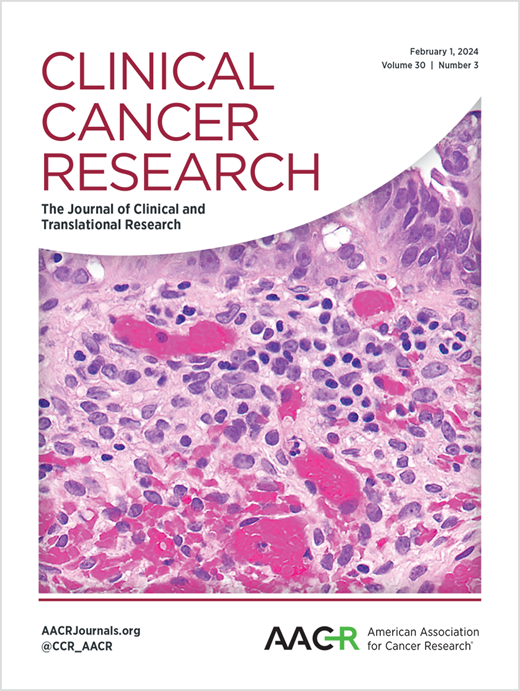Organ preservation via immunotherapy-based total neoadjuvant therapy in early low rectal cancer (TORCH-E): a multicenter, open-label, single-arm, phase 2 study.
IF 10.2
1区 医学
Q1 ONCOLOGY
引用次数: 0
Abstract
PURPOSE Organ preservation (OP) can be preferred in low-lying rectal cancer to reduce morbidity from radical surgery. Immunotherapy-based total neoadjuvant therapy (iTNT) showed remarkable tumor regression and facilitated OP in locally advanced rectal cancer. This study evaluated the efficacy and safety of iTNT, comprising short-course radiotherapy (SCRT) followed by CAPOX and Toripalimab, in enabling OP for early low rectal cancer. PATIENTS AND METHODS TORCH-E was a multicenter, single-arm phase 2 trial enrolling patients with T2-3bN0 rectal adenocarcinoma ≤5 cm from anal verge. Patients received SCRT (25Gy/5Fx) followed by four cycles of CAPOX plus Toripalimab. Good responders were eligible for watch-and-wait (WW) or local excision (LE), total mesorectal excision (TME) was recommended for poor responders or those with high-risk features post-LE. The primary endpoint was complete response (CR), including clinical complete response (cCR) with WW and pathological CR (pCR). Secondary endpoints included OP rate, adverse effects, and quality of life. RESULTS From December 2022 to March 2024, 33 patients were enrolled, with 75.8% staged as T3. After iTNT, 16 patients achieved cCR and adopted WW. pCR was observed in 8/8 LE and 5/9 TME patients. The most common grade 3-4 adverse event was thrombocytopenia (27.3%). After a median follow-up of 24.1 months, four local regrowth and one metastatic recurrence occurred. Total CR rate was 72.7%, and OP rate was 60.6%. CONCLUSIONS As an exploratory trial, TORCH-E demonstrated a promising iTNT approach achieving high CR rate, enabling OP through WW and selective LE in early low rectal cancer, warranting subsequent randomized validation.通过基于免疫疗法的全新辅助治疗早期低位直肠癌器官保存(TORCH-E):一项多中心、开放标签、单臂、2期研究。
目的:低位直肠癌首选器官保留术,以减少根治性手术的发病率。以免疫治疗为基础的全新辅助治疗(iTNT)在局部晚期直肠癌中显示出明显的肿瘤消退和促进OP。本研究评估了iTNT的有效性和安全性,包括短期放疗(SCRT),然后是CAPOX和托里帕利单抗,使早期低位直肠癌的OP成为可能。患者与方法:storch - e是一项多中心、单臂2期临床试验,纳入距离肛门边缘≤5 cm的T2-3bN0直肠腺癌患者。患者接受SCRT (25Gy/5Fx),随后4个周期的CAPOX + Toripalimab。反应良好的患者可接受观察等待(WW)或局部切除(LE),反应差的患者或LE后有高危特征的患者建议接受全肠系膜切除(TME)。主要终点为完全缓解(CR),包括WW的临床完全缓解(cCR)和病理CR (pCR)。次要终点包括手术成功率、不良反应和生活质量。结果从2022年12月至2024年3月,共纳入33例患者,其中75.8%为T3期。经iTNT治疗后,16例患者达到cCR并采用WW。8例LE和5例TME患者均有pCR检测。最常见的3-4级不良事件是血小板减少症(27.3%)。中位随访24.1个月后,发生了4例局部再生和1例转移性复发。总CR率为72.7%,OP率为60.6%。结论:作为一项探索性试验,TORCH-E显示了一种有希望的iTNT方法,可以实现高CR率,通过WW和选择性LE实现早期低位直肠癌的OP,需要后续的随机验证。
本文章由计算机程序翻译,如有差异,请以英文原文为准。
求助全文
约1分钟内获得全文
求助全文
来源期刊

Clinical Cancer Research
医学-肿瘤学
CiteScore
20.10
自引率
1.70%
发文量
1207
审稿时长
2.1 months
期刊介绍:
Clinical Cancer Research is a journal focusing on groundbreaking research in cancer, specifically in the areas where the laboratory and the clinic intersect. Our primary interest lies in clinical trials that investigate novel treatments, accompanied by research on pharmacology, molecular alterations, and biomarkers that can predict response or resistance to these treatments. Furthermore, we prioritize laboratory and animal studies that explore new drugs and targeted agents with the potential to advance to clinical trials. We also encourage research on targetable mechanisms of cancer development, progression, and metastasis.
 求助内容:
求助内容: 应助结果提醒方式:
应助结果提醒方式:


